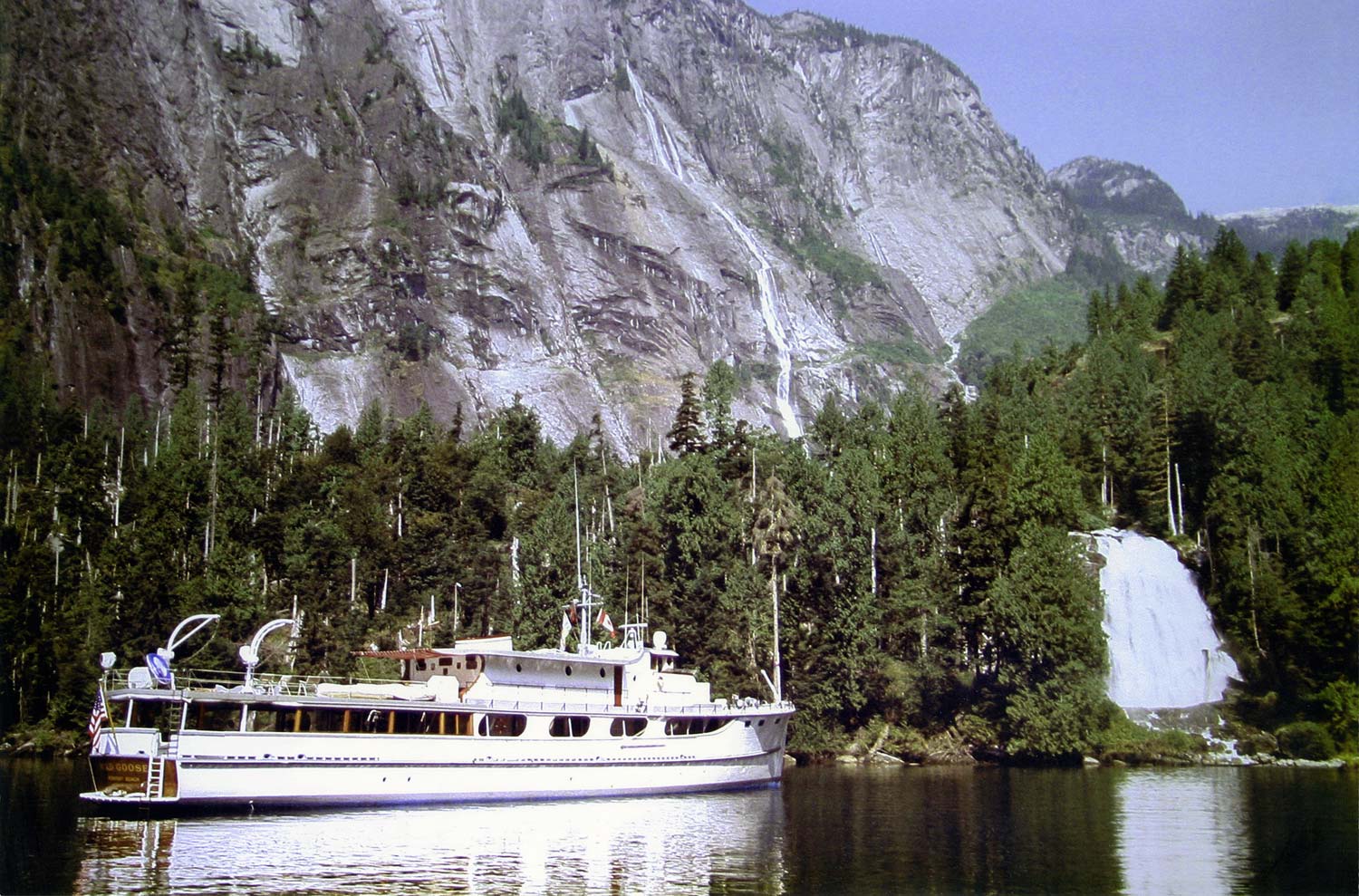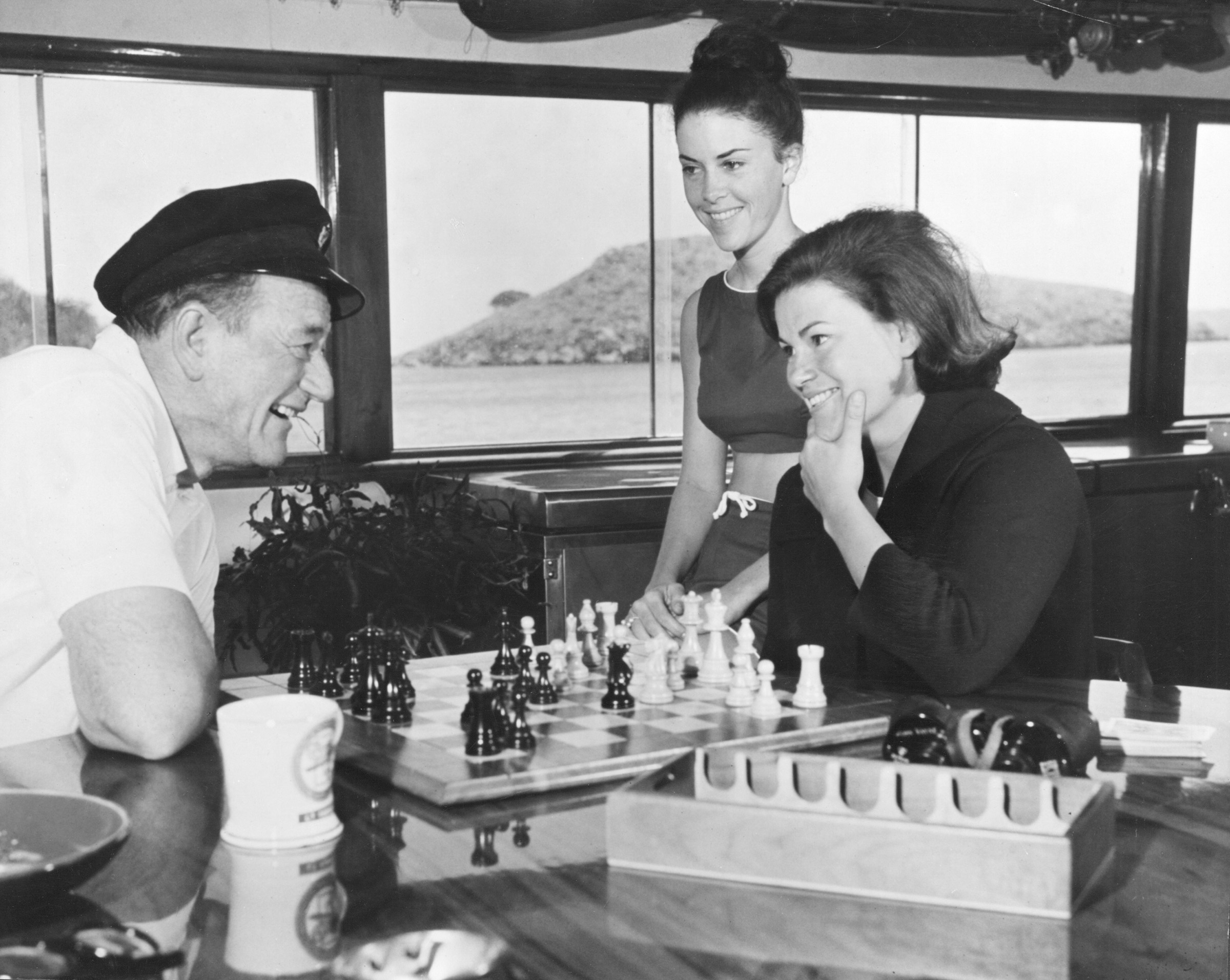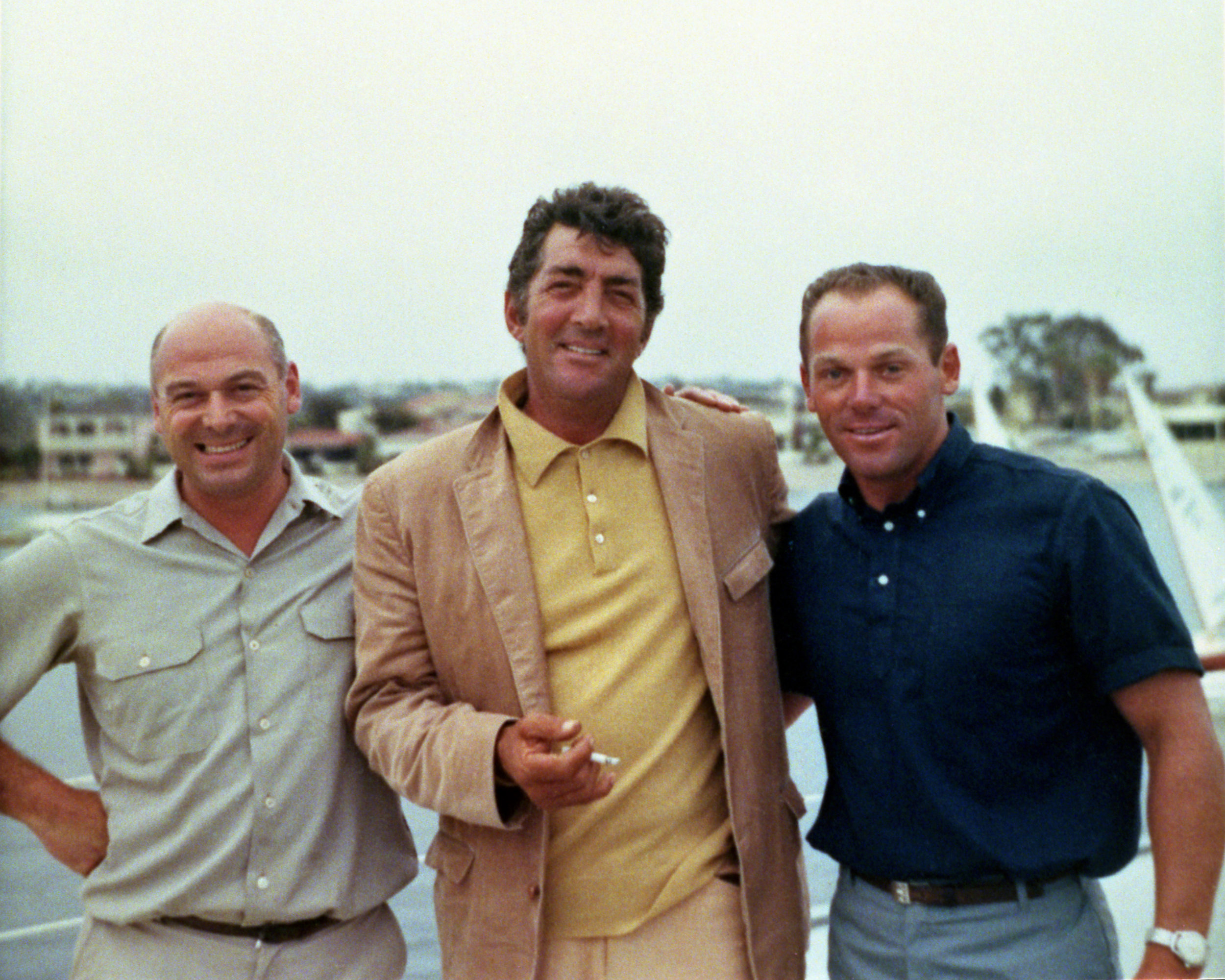The Wild Goose anchored in the Pacific Northwest. Photo courtesy of John Wayne Enterprises
Written by Michael Goldman
If you ever wondered what John Wayne would be doing if he were alive today, with summer in full swing, there is no need—he’d be spending every available moment on his yacht, the Wild Goose, with family and friends. The Wild Goose was a 136-ft. US Navy Minesweeper converted into a yacht that Duke purchased surviving in 1962 to replace the smaller boat he owned a few years earlier, called the Norwester. As his oldest living son, Patrick Wayne said Duke purchased the Wild Goose principally to make it easier to have fun with his family and friends. And for many years, he did just that.
“We had a lot of fun [on the Norwester],” Patrick recalled, “but it wasn’t big enough with our huge extended family, so eventually he decided to buy the Wild Goose.” The yacht has been described as “the central hub of John Wayne’s voracious social life,” and that’s accurate. The boat became such a powerful force in his life, for such a long time, that it remains famous today, long after Duke sold it just a matter of weeks before his death in the late 1970’s as he worked to put his affairs in order. Indeed, the yacht remains in use today, owned by Hornblower Cruises & Events, as a rental yacht for private events in Newport Beach, California.
John Wayne, Peggy Wayne, and Melinda Wayne aboard the Wild Goose in 1963. Photo courtesy of John Wayne Enterprises
But in and around the Wayne family, memories of the boat and its numerous voyages, parties, cruises, and the important snapshots from Duke’s life that played out on it linger. Patrick remembers dozens of adventures on Catalina, and “lots of water sports, fishing, diving for abalone, water skiing.” Daughter Marisa remembers “card games with family and friends on the boat, sailing to Mexico, Canada, or Alaska, fishing and playing backgammon.” In fact, Marisa continues, those times are among her most important memories. “For a long time, whenever I dreamed about him, we were on the boat,” she recalls. “Just enjoying the people you were with, the sights, being on the sea, and lots of playing cards.”
Ethan Wayne describes his dad routinely “putting on his shirt and shoes, or a pair of flip-flops, and then just diving in [off the side of the boat], swimming to shore, putting on his shoes, wet. He’d have something to eat or talk with somebody, and then swim back to the boat and hang out with his buddies.” His wife, Pilar, remembers “cruises to the Panama Canal, spending time in the sun, just relaxing.”
In other words, as Ethan says, days on the Wild Goose were the ones “when my father was the happiest.”
Bert Minshall, who served for many years as the ship’s first mate, and who even wrote a book in the 1990’s filled with his memories of his time on Duke’s boat, called On Board with the Duke, certainly attests to that. He related to me that the feeling was one of family and esprit de corps for anyone on board the Wild Goose. Minshall, in fact, points out that his primary role early in his tenure on the boat was to keep a watchful eye on the younger Wayne children. He remembers “water skiing and jumping off John Wayne’s cabin, about 25 feet in the air,” with Duke’s kids, and insists Duke used the Wild Goose more frequently when he had small children and grandchildren available to join him.
Indeed, Minshall is a veritable gold mine of Wild Goose memories, ranging from screening 16mm versions of John Wayne films on board the ship to watching Duke get a thrill driving the small Boston Whaler ski boat that often came along on cruises, “even though he had a hard time bringing [the ski boat] up alongside the Wild Goose,” according to Minshall. In his own book, Minshall also points out that John Wayne, himself, and Pete Stein were about the only regulars on the boat who “never got seasick” even in the heaviest weather.
“While others covered their mouths and sprinted for the side, the three of us would wipe our plates clean and help ourselves to seconds,” Minshall wrote. “During one particularly fierce storm in the Sea of Cortez, off Baja, California, we were forced to sit on the galley deck, our backs braced against a bulkhead, so we could steady ourselves long enough to wolf down a heavy breakfast.”
Wild Goose Engineer Ken Minshall, Dean Martin, and Wild Goose Captain Bert Minshall aboard the Wild Goose. Photo courtesy of John Wayne Enterprises
Of course, Duke occasionally conducted business meetings on the yacht, but more generally, he wove the boat into the fabric of all aspects of his life. Minshall says Duke took industry friends like actor Hugh O’Brien, Dean Martin, Frank Sinatra, and Jackie Gleason fishing every once in a while, and he let other buddies, including Sammy Davis Jr., charter the boat for Catalina cruises. But, for the most part, the Wild Goose was Duke’s primary personal playground. It was on board the boat that Duke took a three-week fishing trip to Canada and worked with journalist Wayne Warga on several chapters of his never-finished biography in the 1970’s. Among his private papers at the Edward I. Doheny Jr. Memorial Library at USC, Warga wrote about that trip, claiming it began with him getting “rip-snorting drunk with Duke” and was delightful and productive due to how relaxed Duke was.
Duke was also particularly fond over the years of the men, including Minshall, who crewed on the Wild Goose. Letters in the John Wayne Archives, and the memories of family and friends, indicate Duke often battled it out with the ship’s longest-serving skipper, a chain-smoking sea veteran named Pete Stein, in “an interplay,” as Minshall puts it, that might have made them seem like they were at odds. But, in truth, as Ethan Wayne recalls, “they would drink together when the boat was not in operation. They really liked each other.”
When Duke was traveling for work, Stein would routinely write him letters, updating him on the boat’s condition and any issues as they arose. John Wayne appreciated that and, in fact, was so supportive of his crew that he became enraged in 1966 by a letter accusing Captain Stein of being unfit for duty by the owner of another yacht that had gotten into a minor collision with the Wild Goose in Catalina during a voyage in which Duke was not present. The owner of the other boat, in Duke’s view, insulted his friend by calling Stein “arrogant,” and he was having none of it.
“[Stein] recalls nothing discourteous in his actions, and says he took a ten-minute lecture from you without anger or reply,” Duke wrote the man. “It is unfortunate that the incident occurred, but I can’t feel that anything that happened gives you license to damn me and my ship and crew as arrogant. Quite frankly, the tone of your letter fails to invoke a sympathetic or apologetic attitude from me.”
According to Minshall, John Wayne took his final cruise on the boat in April 1979, just a matter of weeks before his death. Minshall says Duke was particularly weak during the trip, but still played backgammon, gin rummy, and reminisced with his old friend.
“When we got back, he walked up the dock, and that was the last time I saw him,” Minshall says. But as melancholy as that memory is for him, it’s overwhelmed by the memories he has of Duke riding in the ship’s wheelhouse, enjoying the sea life and relaxing.
“Duke loved to be in the wheelhouse, usually having a drink,” Minshall says. “At least for the last 10 years or so of his life, he would be up there drinking his tequila or brandy on the rocks. The boat was a real getaway for him, away from the hassle of Hollywood.”





